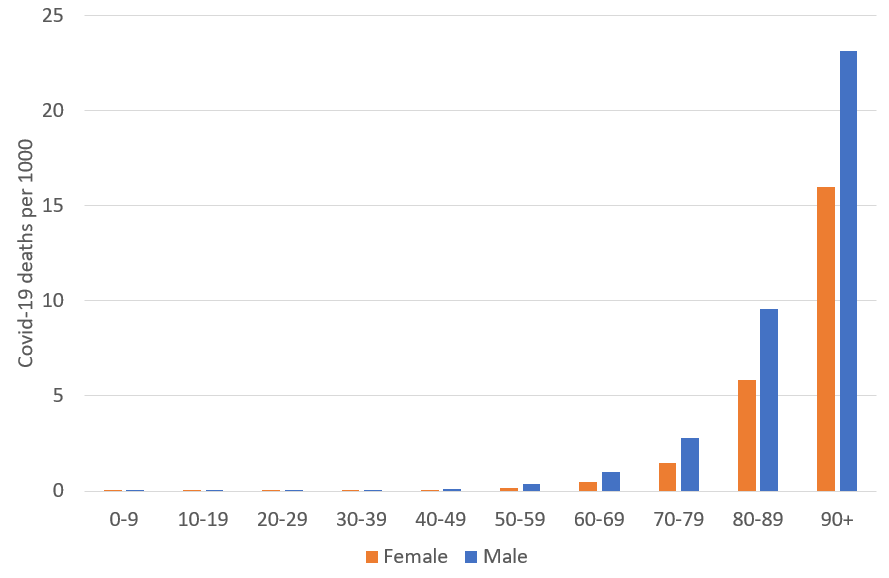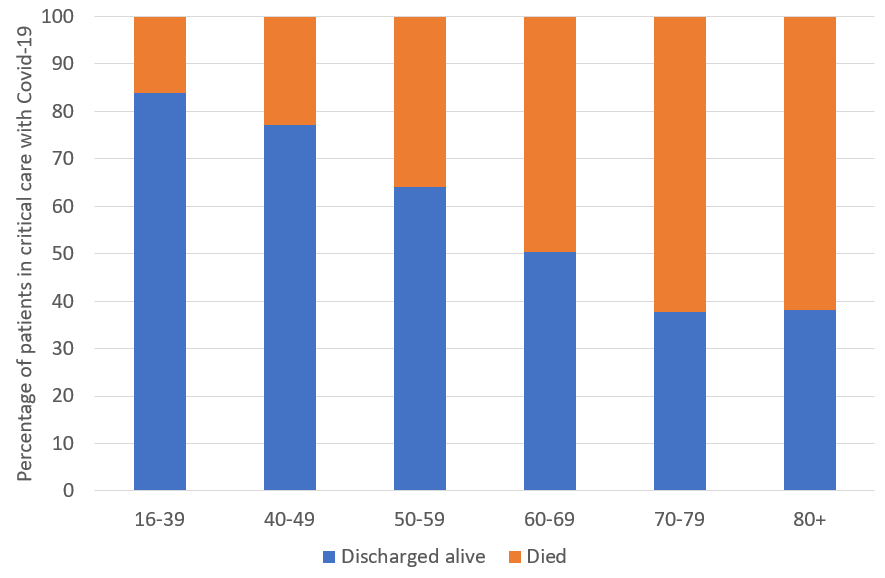The coronavirus situation in England now - November 2021
Dr Elizabeth Webb examines the number of people in the country with coronavirus, the effectiveness of boosters and what we should be doing to continue the fight against the disease.
Since the beginning of the coronavirus pandemic doctors and scientists across the world have found that older people are more likely to have the most severe outcomes. In March we wrote about what the scientists advising the Government thought the risk would be for older people in the UK. Since then, what has happened?
How has coronavirus affected older people?
The Office for National Statistics report that by 29 May more than 46,000 people had died from coronavirus in England and Wales, and that more than 4 in 5 of those people were aged 70 or over. When we look at the number of deaths from coronavirus for each thousand people there is an even more stark relationship.
- In age groups up to and including 60-69, fewer than 1 in 1,000 people have died from coronavirus.
- Age 70-79, it’s 2 in every 1,000 people.
- Age 80-89, it’s 7 in every 1,000 people.
- Age 90 and over, it’s 18 people in every 1,000 people.
- Males have a higher risk in every age group than females.

But what has caused this stark relationship? Is it that older people are more likely to catch coronavirus? Or is it that, having caught it, older people are more likely to die?
Are older people more likely to catch coronavirus?
The Office for National Statistics, with the Department for Health & Social Care and Manchester and Oxford Universities, have tested members of households across England for coronavirus. Their findings suggest that, for people living in their own homes, there are not important differences in how likely people of different ages are to have coronavirus. Men and women also have similar chances of having coronavirus, though people who work outside their home are more likely to have it than people who work at home.
However, this study only tells us about coronavirus 'in the community' and doesn't tell us anything about older people who live in care homes, where the chances of catching coronavirus have been higher. 2 in every 5 care homes have had outbreaks of coronavirus and this has led to more than double the number of deaths of people who live in care homes than would usually be expected. Data from the Office for National Statistics show that in March and April this year, 2 in every 5 people aged 70 and over who died from coronavirus were care home residents.
Altogether, the evidence suggests that the chances of catching coronavirus are affected more by what you do – for example where you live and your profession – than by who you are – for example your age or sex. This suggests that older people living in their own homes are at no greater risk than younger people of catching coronavirus.
How likely are people who catch coronavirus to die from it?
The key statistic to think about when determining how dangerous a new disease is for those who catch it is the Infection Fatality Ratio (IFR). This is the proportion of people who get the disease who die from it. To calculate this we need to know the number of people who have had the disease, as well as the number who have died from it. It is difficult to work out what the IFR is for coronavirus as we don’t know how many people have had it.
Although we don’t know exactly how many people have had coronavirus, the Office for National Statistics study gives estimates that suggest 7% of people in England (around 3.8 million) have had coronavirus during the epidemic. This in turn suggests that the overall IFR is about 1%, so about 1 person is every 100 who catch it will die from it. However, the information we have so far points to the IFR being higher for older people than younger people. This is not something we can yet estimate so for now we have to make do with information that allows us to get closer to understanding how the IFR might vary.
Is coronavirus more dangerous for older people?
The Intensive Care National Audit and Research Centre collects information on people in hospitals across England, Wales and Northern Ireland who are seriously ill with coronavirus. About half of the people in the study are aged 60 and over, suggesting that older people are at higher risk of suffering with coronavirus as this age group makes up only about a quarter of the population.

The study also allows us to understand how the risk of dying for people who receive critical care for coronavirus is related to their age. Overall, about 2 of every 5 patients who receive critical care for coronavirus die. However, this is not the same for people of all ages, with risks, again, being higher for older people. While 1 out of 5 patients aged under 50 died, about 2 out of 5 patients in their 50s, half in their 60s and about 3 out of 5 patients aged 70 and over died.
What conclusions can we draw?
The current evidence suggests that older people who live in the community are not more likely than younger people to catch coronavirus. There is substantial evidence, however, that risks of having a more negative experience are greater the older you are if you do catch it, with risks increasing from people aged 50 and upwards. Age is therefore a very important consideration when we assess our own risk from coronavirus, and when we decide what activities to pursue or avoid.
However, age is not the only characteristic that influences our risk from coronavirus and it should be considered alongside other characteristics that influence risk, including sex, ethnicity, and certain pre-existing medical conditions.

More articles by Dr Webb
Dr Elizabeth Webb is a Senior Research Manager at Age UK. She has an MSc in Epidemiology from the London School of Hygiene and Tropical Medicine and a PhD in Social Epidemiology from University College London.
- What's the science behind the Government's guidelines?
- Can we predict how coronavirus will progress?
- Why are older people more at risk from coronavirus?
- How can we recognise when we have coronavirus?
- How close are we to a vaccine?
- What is R?
- How do we keep R below 1?
- How can you assess your own risk from coronavirus?
- Is there an increased risk of coronavirus for BAME older people?
- What is k and who are the super-spreaders?
Source for ONS graph: Age UK analysis of Office for National Statistics data ‘Deaths registered weekly in England and Wales’ accessed here on 9 June 2020 with ONS mid-year population estimates.
Source for ICNARC graph: Intensive Care National Audit and Research Centre, ‘ICNARC report on Covid-19 in critical care 5th June 2020’ accessed here on 9 June 2020.


